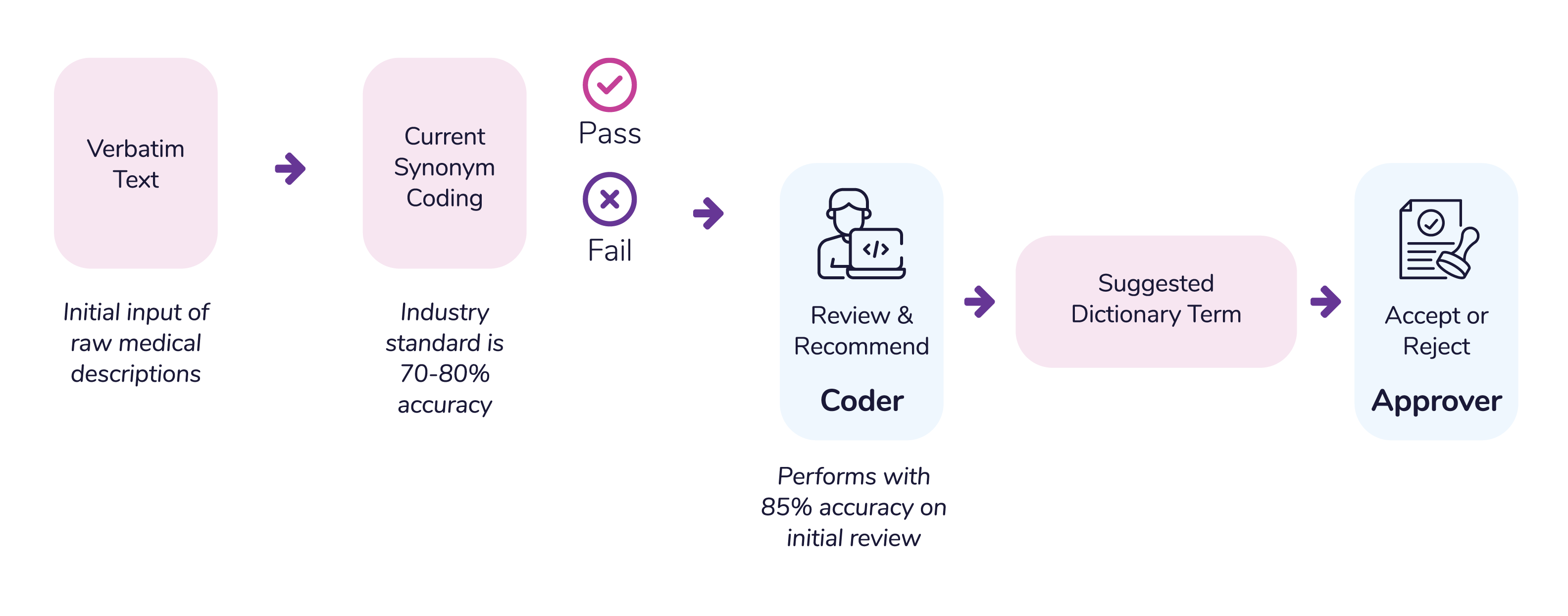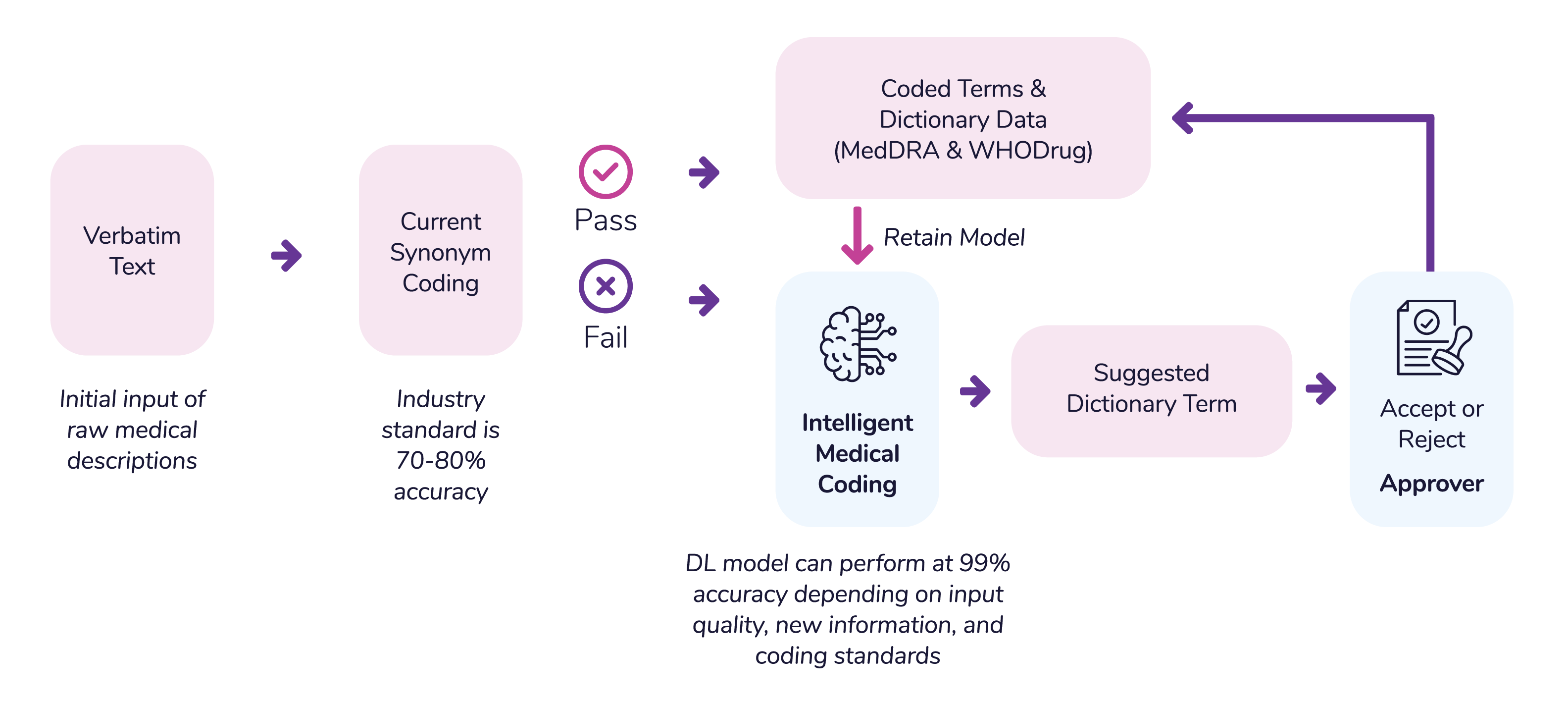A New Era of Automation
In clinical trials, patient data such as adverse events and concomitant medications must be coded against standardized medical dictionaries like MedDRA and WHODrug. This process, known as medical coding in clinical trials, ensures that data is categorized consistently across sites and studies, enabling accurate analysis, regulatory submission, and cross-trial comparisons.
Traditionally, automated tools code only 70–80% of terms, leaving 20–30% for manual review. Coders spend countless hours rechecking terms, resolving discrepancies, and performing duplicate work—all of which makes the process labor-intensive, error-prone, and costly. These inefficiencies often cause inconsistencies in coded data, create delays, and increase trial costs, ultimately slowing time to market for new therapies.
While many organizations are leveraging AI in clinical trials for areas like patient recruitment and monitoring—and exploring new ways to enhance the user experience and extract meaningful insights from data—they often overlook one of the most pressing opportunities: medical coding automation.
Intelligent Medical Coding (IMC) from CluePoints pushes past these challenges by combining automation with advanced Deep Learning (DL) algorithms to deliver faster, more accurate, and more consistent coding results.
A Closer Look at Medical Coding Challenges
The traditional medical coding process in clinical trials typically involves a two-stage model:
- A rules-based automated coding tool assigns codes
- Two human coders manually review the uncoded terms
Basic auto-coding tools paired with synonym lists usually achieve 70–80% accuracy, leaving 20–30% of terms to be manually coded. This gap creates inefficiencies, inconsistencies, and added costs.
To better understand where the process falls short, here are the four biggest challenges of traditional medical coding in clinical trials:
- The Labor-Intensive Nature of Medical Coding
The many manual aspects of medical coding place a significant burden on coders. They spend countless hours meticulously reviewing and verifying codes, yet there remains a possibility of human error. More manual reviews also mean more bottlenecks, slowing down the time to market for trials. - Inconsistencies & Quality Control Issues
Manual coding introduces the risk of inconsistencies across different coders and studies. Even experienced coders can have varying interpretations, leading to discrepancies that compromise the quality and accuracy of the data. These inconsistencies necessitate additional quality control checks, which consume valuable time and resources, further delaying the process. - The Use of Synonym Lists
Synonym lists are pre-defined collections of words and phrases that link different variations of medical terms to a standardized code in dictionaries like MedDRA or WHODrug. They’re designed to help automated coding tools recognize common alternative spellings, abbreviations, or synonyms so that terms can be matched more efficiently without requiring manual intervention. However, these lists have become less accurate as medical dictionaries such as MedDRA and WHODRUG evolve and new versions include previously unseen terms. This leads to more terms needing to be manually coded, adding additional effort for coders. - Delays & Increased Costs
The traditional approach to medical coding typically involves a two-step process in which one coder assigns the codes and another expert performs a secondary review for those not autocoded terms. This adds to the workload and introduces delays and additional unnecessary costs. The need for extensive manual review prolongs the time to market for clinical trials, affecting the overall efficiency of the process.
The Need for Intelligent Medical Coding (IMC)
Recognizing these challenges, CluePoints developed a medical coding solution designed to dramatically improve the coding process. This solution addresses the inefficiencies and obstacles of conventional methods, offering a more automated approach that significantly enhances the accuracy, efficiency, and quality of results.
- Tackling Manual Burdens
Traditional coding requires endless hours of human review. IMC reduces manual intervention by up to 50%, automating repetitive tasks so coders can focus on strategic, value-added work. The result: fewer bottlenecks, faster timelines, and higher productivity.
- Driving Consistency and Accuracy
Manual coding often leads to inconsistent results across coders and studies. IMC eliminates this risk by applying DL models that deliver up to 99% accuracy for MedDRA and 95% for WHODrug. Coding becomes consistent, reproducible, and reliable, reducing the need for extra quality control checks.
- Going Beyond Synonym Lists
Where synonym lists fail to keep pace with evolving dictionaries, IMC supplements. Traditional lists only recognize terms that have been explicitly pre-mapped. IMC’s DL algorithms understand the semantic meaning of terms rather than relying solely on pre-defined matches. This allows the system to correctly interpret and code new or unfamiliar entries without manual intervention, saving coders from constantly updating and maintaining synonym lists.
- Reducing Delays and Costs
Traditional workflows create redundancy and unnecessary expense. IMC streamlines coding reviews, accelerating turnaround times and lowering operational costs.
One major CRO saved 55% of time spent coding with CluePoints’ Intelligent Medical Coding tool.
The Future of Medical Coding in Clinical Trials
With CluePoints, medical coding becomes a swift and harmonious blend of automation and human expertise, removing the heavy manual burden while retaining the oversight that ensures trust and reliability. By combining DL algorithms with intelligent automation, IMC directly addresses every major challenge of traditional coding, delivering measurable improvements in speed, quality, and consistency. The benefits of CluePoints’ IMC are clear:
- Automate more of the coding process: Eliminate repetitive, low-value tasks and free coders to focus on higher-level activities.
- Increase accuracy with DL algorithms: Achieve up to 99% accuracy in MedDRA and 95% in WHODrug, ensuring precise, reproducible results across studies.
- Reduce manual effort and boost productivity: Cut manual intervention by as much as 50%, saving both time and resources.
- Ensure greater consistency and quality control: Apply uniform, algorithm-driven logic that reduces variability and minimizes the need for rework.
- Streamline workflows and accelerate time to market: Shorten review cycles, cut costs, and speed up clinical trial delivery.
Moreover, our DL model leverages insights from automated medical coding and the decisions of medical coders to continuously maintain and improve the suggestions sent for each verbatim. This advancement transforms coders’ roles from essential data management to more analytical data science tasks. Coders now focus more on approving, reviewing, and analyzing coding trends, which adds value by enabling deeper insights into clinical trial data.
Learn more about our IMC solution to experience the fundamental improvements that will optimize your operations. Contact CluePoints today.



